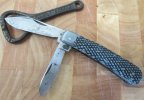- Joined
- Dec 2, 2005
- Messages
- 71,095
The BladeForums.com 2024 Traditional Knife is available! Price is $250 ea (shipped within CONUS).
Order here: https://www.bladeforums.com/help/2024-traditional/
I could find this and this , along with a lot of very different images, with 'knives', (lancets), which generally have a more medical appearance. While unusual, I do see knives like the one I have fairly regularly in antique shops.Can you supply some more information about this please?
Whoda thunkit???I could find this and this , along with a lot of very different images, with 'knives', (lancets), which generally have a more medical appearance. While unusual, I do see knives like the one I have fairly regularly in antique shops.
That is interesting. Ivory can be sharpened enough to cut the skin? Or am I misunderstanding?I could find this and this , along with a lot of very different images, with 'knives', (lancets), which generally have a more medical appearance. While unusual, I do see knives like the one I have fairly regularly in antique shops.
It definitely can !! Ivory is tough stuff!!That is interesting. Ivory can be sharpened enough to cut the skin? Or am I misunderstanding?
That is interesting. Ivory can be sharpened enough to cut the skin? Or am I misunderstanding?
It definitely can !! Ivory is tough stuff!!
You scratch the skin in a pattern to apply the vaccine!!

Wow, that's really interestingHere’s one that’s a bit different. Marked Gilt-Edge can’t read what’s below that. That was a trademark used by Farwell-Ozmun-Kirk & Co St Paul Minn. They bought Henry Sears & Son in 1897. It’s a handle for a buggy whip. Patent date is Nov 11, 1884. Pretty cool knife. View attachment 2493833View attachment 2493834View attachment 2493835View attachment 2493836View attachment 2493837



Thanks, it's kind of cheap. but I was very pleased to find itNice!!!

That's interesting Isk, beautiful tooAnother fruit knife, this time with a seed pick.


That's interesting Isk, beautiful too

